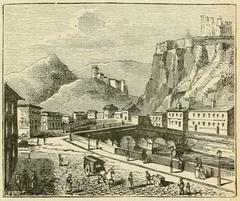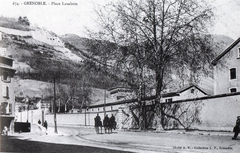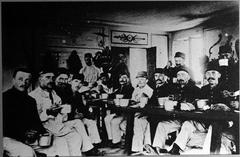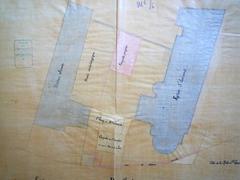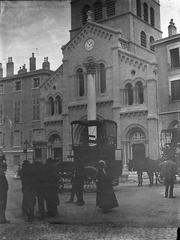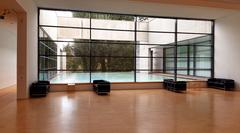
Grenoble Railway Station: Visiting Hours, Tickets, and Comprehensive Travel Guide
Date: 03/07/2025
Introduction to Grenoble Railway Station
Grenoble Railway Station (Gare de Grenoble) is a crucial transportation hub in southeastern France, serving as the main gateway to the city of Grenoble, the French Alps, and the broader Auvergne-Rhône-Alpes region. Since its opening in 1849, the station has grown from a small regional stop to a modern, bustling interchange that connects travelers to Paris, Lyon, Marseille, Geneva, and countless Alpine resorts. Its strategic position at the confluence of the Drac and Isère rivers, as well as near major ski destinations, makes it indispensable for commuters, tourists, and business travelers.
The station’s history is marked by significant transformations, particularly its comprehensive modernization for the 1968 Winter Olympics, which set a new standard for infrastructure and positioned Grenoble as an international winter sports destination. Today, the station balances its historical legacy with modern amenities—offering accessible facilities, integrated tram and bus connections, 24/7 ticketing, and seamless links to regional, national, and international rail services. Nearby, visitors can easily access Grenoble’s Old Town, the Bastille Fortress, and leading cultural institutions.
This detailed guide provides essential information on visiting hours, ticketing, accessibility, and travel tips, while highlighting the station’s role in regional development and sustainable mobility. For the latest updates and further details, consult the station’s Wikipedia page and travel resources like BonjourLaFrance.
Contents
- Historical Overview
- Visiting Hours, Ticketing, and Accessibility
- Station Facilities and Services
- Transport Connections
- Nearby Attractions and Travel Tips
- Regional and National Significance
- Frequently Asked Questions (FAQs)
- Conclusion and Recommendations
- Sources and Further Reading
Historical Overview
Early Development (1849–1960s)
Grenoble Railway Station opened on January 3, 1849, as part of the expansion of the Lyon–Marseille and Grenoble–Montmélian railways (Wikipedia: Grenoble station). The arrival of the railway in 1858 was a catalyst for Grenoble’s industrial and demographic growth (Wikipedia: Grenoble), supporting its burgeoning industries such as hydroelectric power and paper manufacturing.
Architectural Evolution
- 19th–Early 20th Century: The original station was functional, growing steadily in size and capacity to serve increasing passenger and freight demands.
- 1967–68 Modernization: Ahead of the 1968 Winter Olympics, the station underwent a major rebuild, introducing contemporary design, expanded platforms, and better facilities to accommodate a global influx of visitors (Wikipedia: Grenoble station; Wikipedia: Grenoble).
- Recent Upgrades: Electrification of key lines such as Valence–Grenoble and Grenoble–Chambéry has improved operational efficiency and sustainability (Wikipedia: Grenoble station).
Visiting Hours, Ticketing, and Accessibility
Visiting Hours
- Station Opening: Generally open daily from 5:00 AM to 11:30 PM (may vary slightly by season or service schedules).
- Ticket Counters: Open from 6:00 AM to 8:00 PM.
- Self-Service Machines: Available 24/7 for ticket purchase and collection.
Ticketing Options
- Types: Purchase tickets for TGV high-speed, TER regional, and select international trains.
- How to Buy:
- At staffed counters during opening hours
- At multilingual self-service machines
- Online via official SNCF, Omio, or Trainline websites and mobile apps
- Tips: Book in advance for TGV/peak periods. Discounted fares available for youth, seniors, and groups.
Accessibility
- Facilities: Step-free platform access, elevators, ramps, accessible restrooms, and tactile paving for visually impaired travelers.
- Assistance: Pre-booked assistance services for travelers with reduced mobility; recommended to request at least 24–48 hours in advance.
Station Facilities and Services
- Information: Multilingual signage (French/English) and a tourist information desk.
- Waiting Areas: Comfortable, climate-controlled lounges with device charging points.
- Wi-Fi: Complimentary access throughout the station.
- Shopping & Dining: Newsstands, convenience stores, souvenir shops, cafés, and restaurants serving local and international cuisine (The Trainline).
- Luggage: While there are no on-site lockers, nearby city services offer baggage storage. Luggage trolleys are available.
- Security: CCTV, regular security patrols, lost and found office.
- Parking: Secure car parks (short and long-term), bicycle racks, and facilities supporting eco-friendly travel.
- Business Services: ATMs, business workspaces with charging points.
Transport Connections
Local Integration
- Tram Lines: A and B stop outside the station, linking to city center and suburbs.
- Buses: Numerous routes connect the station to regional destinations and tourist sites.
- Bike Facilities: Rental and secure parking available.
Regional & National Rail
- TGV: Direct high-speed service to Paris (approx. 3 hours), Lyon, Marseille, Avignon, Geneva, and more (BonjourLaFrance: Gare de Grenoble; Euro-Train: Grenoble Station).
- TER: Frequent regional trains to Lyon, Valence, Chambéry, Annecy, and Swiss destinations.
Other Transport
- Taxis: Available 24/7 outside the station.
- Car Rentals: Agencies nearby for flexible exploration.
Nearby Attractions and Travel Tips
- Grenoble Old Town: Historic streets, architecture, museums, and cafés—10–15 minutes by tram or on foot.
- Bastille Fortress: Access via a scenic cable car ride; panoramic city and mountain views.
- Musée de Grenoble: One of France’s premier art museums, reachable by tram.
- Place Grenette & Parc Paul Mistral: Iconic city square and urban park, both walkable from the station.
- Alpine Ski Resorts: Direct TER/bus links to renowned winter and summer sports destinations.
Travel Tips:
- Arrive early for ticketing and platform navigation, especially during peak periods.
- Use free Wi-Fi for real-time schedule updates.
- For accessibility needs, contact the station in advance.
- Download travel apps for real-time information and ticket management.
Regional and National Significance
Grenoble Railway Station is a linchpin in France’s rail network, vital for the region’s economy, tourism, and sustainable mobility. Its modernization and integration with Grenoble’s 100% accessible Mréso public transport system set benchmarks for inclusivity and environmental responsibility. The station’s connectivity supports the city’s role as a research, technology, and winter sports hub (Wikipedia: Grenoble; BonjourLaFrance: Gare de Grenoble).
Frequently Asked Questions (FAQs)
Q: What are Grenoble Railway Station’s opening hours?
A: Approximately 5:00 AM to 11:30 PM daily; ticket counters 6:00 AM to 8:00 PM.
Q: How do I purchase tickets?
A: At the station (counters or machines), or online/mobile apps (SNCF, Omio, Trainline).
Q: Is the station accessible for travelers with disabilities?
A: Yes, with step-free access, elevators, accessible restrooms, and assistance services.
Q: Are there luggage storage facilities?
A: No on-site lockers, but city storage options are available nearby.
Q: What attractions are close to the station?
A: Musée de Grenoble, Bastille Fortress, Old Town, and Parc Paul Mistral.
Conclusion and Recommendations
Grenoble Railway Station stands as a model of historical legacy and modern efficiency, providing seamless connections to local, regional, and international destinations. Its comprehensive amenities, integrated transport, and accessible design make it the ideal starting point for discovering Grenoble, the Alps, and the cultural richness of southeastern France. For the latest information on schedules, tickets, and events, utilize digital tools like the Audiala app and consult official tourism resources.
Sources and Further Reading
- Grenoble station, 2024, Wikipedia
- Grenoble, 2024, Wikipedia
- Gare de Grenoble Train Station, 2024, BonjourLaFrance
- Gare de Grenoble, 2024, Omio
- Escape to Grenoble: The Capital City of the French Alps, 2024, The Trainline











